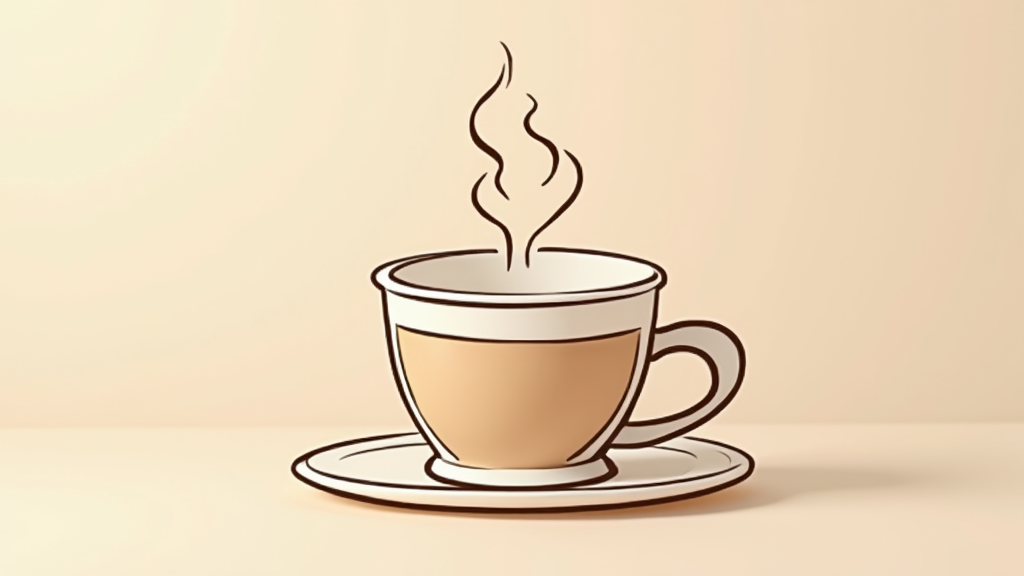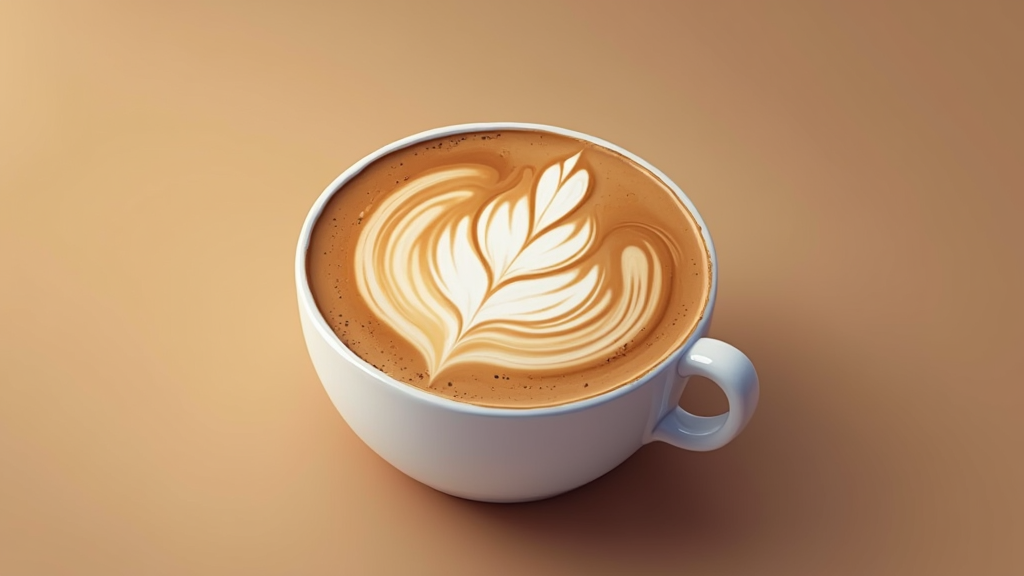Table of Contents
- Understanding the Coffee Latte Outline
- Dissecting the Coffee Latte Outline: Foundational Elements
- Creating Your Perfect Coffee Latte Outline: A Detailed Guide
Understanding the Coffee Latte Outline

Coffee Latte Defined: Espresso and Steamed Milk
A latte is a beloved coffee beverage primarily composed of espresso and steamed milk, finished with a delicate layer of milk foam. The beauty of a latte lies in its simplicity and balance, allowing the creamy texture of the milk to complement the robust flavor of the espresso.
Originating from the Italian term “caffè latte,” which literally means “milk coffee,” the latte emphasizes the harmonious blend of coffee and milk. This combination creates a smoother, sweeter coffee experience compared to drinks where espresso dominates.
In a well-crafted latte, the milk’s natural sweetness is accentuated, providing a mellow counterpoint to the espresso’s intensity. This focus on milk distinguishes it from other espresso-based drinks like cappuccinos or macchiatos.
Coffee Latte’s Rise to Global Popularity
The coffee latte gained significant traction in the United States during the 1980s, particularly in coffee-centric cities such as Seattle. Its widespread appeal transformed coffee culture and established the latte as a staple in cafes worldwide.
While the exact origins are debated, some theories suggest the latte was an American invention that emerged after World War II. Others attribute its creation to Italian-style coffee shops in California during the 1950s, catering to a demand for milder coffee options.
The latte’s approachable flavor profile has made it a popular “gateway” coffee drink for many. Its mildness and inherent sweetness make it an excellent choice for those new to espresso-based beverages.
Key Elements of Our Coffee Latte Outline
This coffee latte outline will provide a comprehensive understanding of what constitutes a perfect latte. We’ll delve into the core components, focusing on espresso, steamed milk, and the subtle art of milk foam creation.
You’ll learn the essential preparation techniques for both espresso and milk, ensuring you have the skills to create a café-quality latte in your own kitchen. Mastering these skills is fundamental to achieving the ideal texture and flavor balance.
Finally, we will explore a variety of latte variations, flavor combinations, and alternative methods for crafting this classic beverage at home. From flavored syrups to non-dairy options, you’ll discover how to customize your latte to suit your personal preferences.
Dissecting the Coffee Latte Outline: Foundational Elements
Fundamental Coffee Latte Outline: Core Concepts
**Option 1 (Focus on Milk Choice):**
> The secret to latte perfection lies in the milk. While whole milk creates the richest, most stable foam, don’t hesitate to experiment with oat milk for a delicious non-dairy alternative that froths beautifully and complements espresso’s flavor.
**Option 2 (Focus on Espresso Quality):**
> Don’t underestimate the importance of the espresso roast. While dark roasts like Starbucks Espresso Roast are classic, exploring lighter and medium roasts can unlock unique and nuanced flavor profiles in your latte.
**Option 3 (Focus on Foam Technique):**
> Achieving that perfect latte texture is all about the microfoam. Aim for a “wet-paint” consistency and reserve a small amount for topping to create a visually appealing and creamy first sip.
A latte, at its heart, is a harmonious blend of espresso and steamed milk, crowned with a delicate layer of foam. Understanding this basic definition is the first step in mastering the coffee latte outline.
The classic latte proportions typically involve a ratio of two fluid ounces of espresso to approximately three fluid ounces of steamed milk. This balance ensures a creamy texture without overpowering the coffee’s inherent flavor.
Compared to bolder coffee preparations like espresso or Americano, the coffee latte presents a smoother and milder flavor profile, making it a popular choice for those who prefer a less intense coffee experience.
Essential Components in a Coffee Latte Outline
Creating the perfect latte involves carefully selecting and preparing each of its core components. Let’s break down the essentials:
- <strong>Espresso:</strong> The foundation of any great latte. Use a finely ground espresso roast coffee.
- <strong>Milk:</strong> The key to a creamy and satisfying latte.
- <strong>Foam:</strong> The finishing touch, adding a textural element to the latte.
- <strong>Optional Additions:</strong> Enhance the latte’s flavor profile.
<strong>Espresso:</strong> The foundation of any great latte. Use a finely ground espresso roast coffee.
- Starbucks® Espresso Roast, known for its dark roast and notes of molasses and caramelized sugar, is a popular choice.
- Premium light and medium roasts can also be used for a different flavor profile.
Starbucks® Espresso Roast, known for its dark roast and notes of molasses and caramelized sugar, is a popular choice.
Premium light and medium roasts can also be used for a different flavor profile.
<strong>Milk:</strong> The key to a creamy and satisfying latte.
- Whole milk is generally recommended as it provides the richest flavor and best foam.
- 2% milk can be used as an alternative, although it may lack some of the richness of whole milk.
- Non-dairy options, such as oat milk (like Pacific Barista Oat Milk), are excellent choices, offering great frothing capabilities and a complementary flavor.
Whole milk is generally recommended as it provides the richest flavor and best foam.
2% milk can be used as an alternative, although it may lack some of the richness of whole milk.
Non-dairy options, such as oat milk (like Pacific Barista Oat Milk), are excellent choices, offering great frothing capabilities and a complementary flavor.
<strong>Foam:</strong> The finishing touch, adding a textural element to the latte.
- Aim for a light layer of microfoam, characterized by its smooth, “wet-paint” consistency.
- A small amount of foam is reserved for topping the latte, providing a visual appeal and a creamy first sip.
Aim for a light layer of microfoam, characterized by its smooth, “wet-paint” consistency.
A small amount of foam is reserved for topping the latte, providing a visual appeal and a creamy first sip.
<strong>Optional Additions:</strong> Enhance the latte’s flavor profile.
- Vanilla Syrup (either homemade or store-bought) is a common and delicious addition.
- Sugar-free syrups, often using Sucralose, allow for a customized sweetness without the added sugar.
Vanilla Syrup (either homemade or store-bought) is a common and delicious addition.
Sugar-free syrups, often using Sucralose, allow for a customized sweetness without the added sugar.
Creating Your Perfect Coffee Latte Outline: A Detailed Guide

**Option 1 (Focus on accessibility):**
> Crafting the perfect latte at home is achievable with simple tools and techniques. Even without fancy equipment, you can use a French press, whisk, or even a jar to create beautifully frothed milk and enjoy a delicious, customized latte.
**Option 2 (Focus on customization):**
> Experimentation is key to latte perfection. From exploring different milk types and flavorings to mastering latte art, personalize your drink to match your taste and elevate your coffee experience.
**Option 3 (Focus on safety and quality):**
> Prioritize safety by avoiding overfilling when brewing espresso and handling hot milk with care. Using fresh, high-quality ingredients and mastering the frothing technique are crucial for achieving the best-tasting latte.
Coffee Latte Outline: Essential Materials and Preparation
Before diving into the art of latte making, gathering the right materials and equipment is crucial. This ensures a smooth and enjoyable brewing experience. Here’s what you’ll need:
- Required Materials:
- Espresso roast coffee (finely ground for optimal extraction).
- Milk (whole milk provides the richest texture, but 2% or non-dairy alternatives like oat or almond milk work well too).
- Optional: Vanilla syrup, cinnamon, or caramel syrup for added flavor.
- Required Equipment:
- Espresso machine or Moka pot (for brewing strong coffee).
- Milk frother (espresso machine with steamer, handheld frother, French press, or even a whisk).
- Latte cup (designed to accommodate both espresso and a generous amount of foamed milk).
Initial Setup: Pre-warming your latte cup is a simple yet effective trick to maintain the espresso’s temperature. Also, ensure your milk is fresh; this significantly impacts its ability to froth properly.
Coffee Latte Outline: Step-by-Step Brewing Instructions
Now that you have your materials ready, let’s walk through the latte-making process, step by step. The key is to focus on both the espresso and the milk to achieve the perfect balance.
Brewing Espresso:
- Fill the lower chamber with warm or hot, preferably filtered water, up to just below the safety valve.
- Fill the filter basket with leveled, but not compacted, freshly ground coffee.
- Assemble the pot and heat it on medium heat until a gentle gurgling sound occurs. Immediately remove it from the heat to prevent a burnt taste.
Steaming and Frothing Milk:
- Handheld milk frother: Submerge the frother in the milk and froth until doubled in volume.
- French press: Heat the milk, pour it into the French press, and pump the plunger up and down until foamy.
- Whisk: Vigorously whisk the heated milk until foamy.
- Jar: Pour warm milk into a jar, seal it tightly, and shake vigorously until foamy.
Assembling the Latte:
Perfecting Your Coffee Latte Outline: Advanced Techniques
Once you’ve mastered the basic latte, you can explore advanced techniques to elevate your coffee experience. From flavor variations to troubleshooting common issues, here are some tips to help you perfect your coffee latte outline.
Expert Tips:
- Always use fresh, high-quality coffee beans for the best flavor.
- Experiment with different types of milk to find your preferred texture and taste. Oat milk and barista blends are great for non-dairy lattes.
- Practice latte art! With a steady hand and the right milk texture, you can create beautiful designs on top of your latte.
- Manually frothing milk with a whisk or jar is a viable alternative if you don’t have a dedicated milk frother.
Flavor Variations:
- Add spices like cinnamon, nutmeg, or pumpkin spice for a seasonal twist.
- Experiment with flavored syrups, such as vanilla, caramel, or lavender, to create unique flavor profiles.
- For a refreshing treat, serve your latte iced by pouring the espresso and milk over ice.
- Make your own vanilla syrup by simmering sugar, water, and a vanilla bean (or vanilla extract) for a more natural and flavorful sweetener.
Troubleshooting:
- If your milk isn’t frothing well, make sure it’s fresh and cold. Also, check that your frothing technique is correct.
- If your espresso tastes too bitter, adjust the grind size to be coarser or try using a different roast of coffee.

